Simple ways to save rose cuttings until spring and plant them correctly
Lush rose gardens will add zest to any garden. Even a small flowering bush near the steps will make the porch of the house more sophisticated.
Planting a rose garden begins with preparing cuttings for planting in the spring. Seedlings with a ready-made root system are bought at a gardening store or prepared independently. We will tell you how to save rose cuttings until spring, check them for safety and plant them.
Selection and preparation of rose cuttings for storage until spring
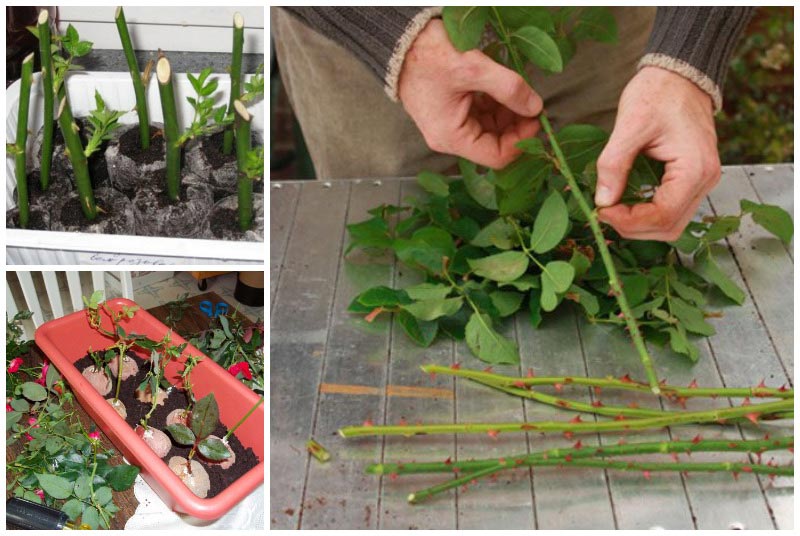
Cuttings - the easiest and most reliable way to propagate roses. In order for flowers to grow quickly in spring, it is important to properly prepare the material at the end of summer or autumn. Before pruning, the bush is carefully inspected, only thick and healthy shoots are selected. This guarantees rapid survival of plants in the soil after planting.
The stems should be green, elastic, without young shoots and leaves, traces diseases and insect damage. It is recommended to cut shoots from the middle part of the branch. The optimal thickness of the shoot is 4-5 mm, length - from 20 cm.
The work uses a sharpened pruner or knife, disinfected in alcohol or boiling water. The lower cut is made at an angle of 45° below the last bud. The upper cut is made straight, 2-3 cm above the bud. Movements must be precise and sharp. The branches are cleared of leaves and the cuts are dipped in liquid paraffin to prevent germination and evaporation of moisture.
Reference. In temperate climates, rose bushes are pruned at the end of September, leaving 3-4 shoots 30–50 cm long.
It is recommended to dig up cuttings of roses that were planted in summer and store them, since their root system is not yet sufficiently developed and will not survive the winter. This is a prerequisite for growing roses in regions where the air temperature in winter drops below -35°C.
What conditions do cuttings require for preservation?

To preserve them, rose cuttings are kept in a cellar or basement until spring. The material is tied into bundles of 10 pieces, placed in boxes and covered with sand. The room temperature should be in the range –4…+7°С. At higher values, the cuttings will begin to germinate ahead of time; at lower values, they will freeze.
Optimal air humidity is 65–70%. At higher rates, the planting material will begin to rot, and in an excessively dry room it will dry out.
Some people place the cuttings vertically in a soil mixture of sod, peat and perlite (4:2:1). The container is wrapped in thick black polyethylene to block access to sunlight. Once a month, the film is removed to ventilate the cuttings. Each of them is carefully inspected for the presence of rot, and the soil mixture is watered if necessary.
Methods for storing rose cuttings
In addition to basement storage, there are several ways to keep cuttings until spring: on the balcony, in the ground, in the refrigerator, in moss or potatoes, under rose bushes and snow.

Winter storage in the ground
The method of storing cuttings in the ground is suitable for regions with warm climates, if the grower does not have the opportunity to place planting material in the cellar. Depending on the number of cuttings, dig a trench or hole 20–50 cm deep.The bottom is lined with spruce branches, dry branches, boards, straw or agrofibre.
The cuttings are laid out on top so that they do not touch. Next, lay another layer of covering material and cover everything with soil. To find the storage location, the trench is marked with posts or wooden pegs.
Some gardeners store planting material in a special cuttings, which looks like a bed with a homemade frost shelter. The cuttings are stuck into the soil at an angle of 45° and each of them is covered with a glass jar or plastic bottle with a cut bottom. As soon as the air temperature reaches above zero, the shelter is removed and the cuttings are left to grow in the same place until autumn.
On the balcony
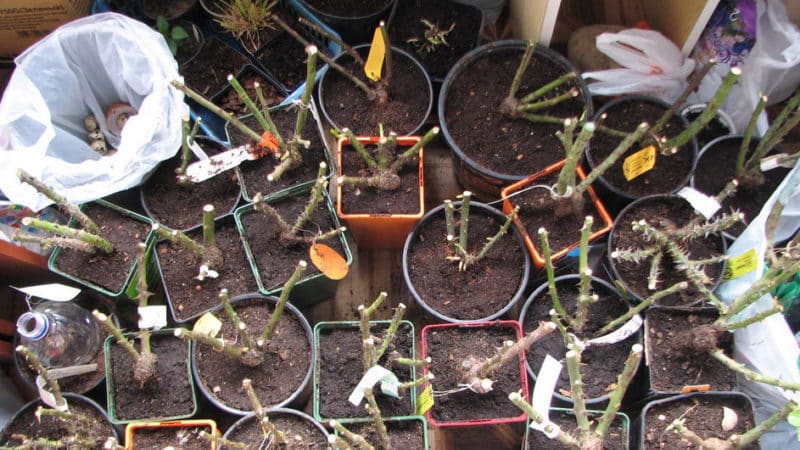
This method is suitable for city residents who go to their dacha only with the arrival of spring. With the onset of the first autumn frosts, the cuttings are cut off, leaving 2-3 buds. A thick layer of expanded clay is poured into a plastic bucket, and on top - sod from the garden mixed with perlite (4:1). The prepared soil mixture is watered abundantly with settled water.
Each cutting is dipped cut-wise into water, then into a solution of a growth stimulator. The material is placed in small recesses and wrapped in polyethylene. The container is wrapped in a thick blanket or blanket and taken out onto the balcony. If the floor is cement, place boards or foam plastic under the bucket.
In sunny weather, the cover is removed and the cuttings are sprayed with Epin solution. After complete drying, the planting material is re-wrapped. If the air temperature at night drops below -20°C, the container is brought indoors.
Under the rose bushes
This is one of the simplest storage methods that does not require much effort on the part of the grower. It is used for simultaneous cultivation of several varieties of roses.
The petioles are buried under the bush of the corresponding variety in the following sequence:
- the hole is made up to 15 cm deep;
- cover the bottom with cotton cloth;
- fill the holes with cuttings in the amount of 10–15 pieces;
- A layer of fabric is placed on top of the planting material and sprinkled with earth.
In the snow
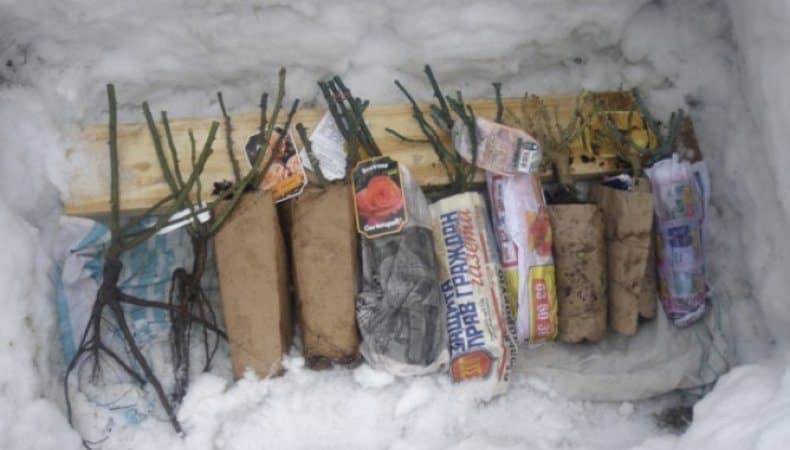
In the garden plot, they dig holes 15–20 cm deep. The bottom is covered with agrofibre, cuttings without leaves are placed on top, everything is covered with a cloth and covered with soil. In winter, snow is piled on top and small mounds are formed. In this form, the cuttings are stored until spring. In the first ten days of March, they are dug up and inspected for callus (growths in the root area), and then planted in prepared holes.
In a refrigerator

If it is not possible to store cuttings in the cellar, a refrigerator is perfect for this purpose. The optimal humidity in the refrigerator compartment should be 90–95%, temperature should not exceed +5°C.
The prepared cuttings are wrapped in cellophane so that air penetrates inside. The bundles are placed in the bottom drawer close to each other. Once a month, the wrapper is removed and the cuttings are carefully inspected for rot and mold. If the sections are dry, they are sprayed with clean water from a spray bottle. Mold is removed with a soft brush or damp cloth, and rotten cuttings are thrown away.
Using moss
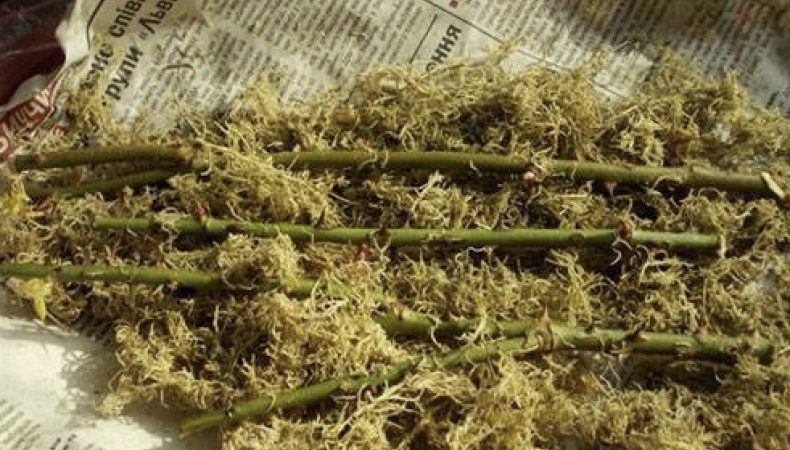
Sphagnum moss is used to store rose cuttings.. The prepared material is wrapped in moss, previously soaked in a Fitosporin solution. The sections are soaked for 20–30 minutes in a growth stimulator. The cuttings are placed in a tight bag and taken for storage in a cellar or basement. You can keep them on the bottom shelf of the refrigerator. The bag is periodically opened and ventilated, the branches are carefully inspected, and the moss is sprayed with clean water.
Reference. Sphagnum has antibacterial properties and retains moisture, so rose cuttings are perfectly stored until spring.
At the beginning of March they begin rooting Cherenkov. The moss wrapper is removed and the thorns are cut off. The bottom of a cardboard or plastic box is lined with fresh sphagnum moss, and 3 cm of river sand washed under the tap is poured on top. The cuttings are planted so that 1-2 buds remain above the sand layer. The seedlings are covered with polyethylene and several holes are made in it to allow fresh air to enter.
The box is placed in a warm, well-lit room. It is important to constantly monitor the soil moisture and water it as the top layer dries.
Rooted in potatoes
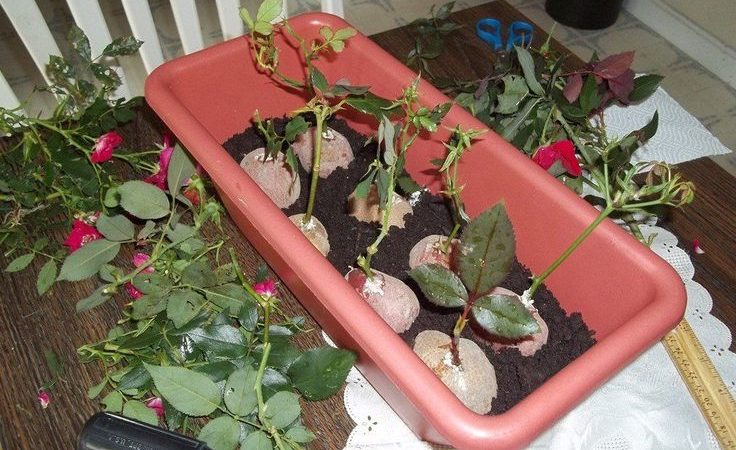
Flower growers often practice rooting rose cuttings in potato tubers. Thanks to the starch and nutritional components contained in the vegetable, the cuttings grow quickly in the spring and reproduce.
Tubers should be of medium size, without external damage. They are treated with a fungicide solution (Strobi, Quadrisa, Horus, Delana, Acrobat, Ditana) and the eyes are removed. Most of the foliage is removed from the cuttings and the sections are treated with a pink solution of potassium permanganate. It is recommended to immerse the cuttings in aloe juice for 12 hours so that they are saturated with moisture and the cut remains fresh longer. Instead of aloe, a growth stimulator (Epin or Zircon) is used.
A depression is made in the tubers and a cutting is placed. It is advisable to seal the top cut with paraffin. The tubers are dropped into an opaque pot and watered with a strong solution of potassium permanganate. Instead of a pot, use thick plastic bags and hang them on the window. After 2-3 weeks the buds will begin to grow.
The cuttings are regularly watered with clean water at room temperature, granulated sugar is added to the liquid once a week (1 tbsp per 200 ml of water) to replenish carbohydrates.
The planting material is covered with a glass jar or plastic bottle and watered well. The soil should be constantly moist, but not excessively. The root system begins to develop simultaneously with new shoots. After 2-3 weeks, the pots are taken out into fresh air. The shelter is slightly raised and fixed in this position. Start with 15 minutes and gradually increase to 24 hours. When the plant gets used to the open air, the shelter is completely removed.
When to plant saved cuttings
There is no specific time for planting roses in the spring. It all depends on the climatic conditions in the region. Before planting, cuttings must be checked for safety.
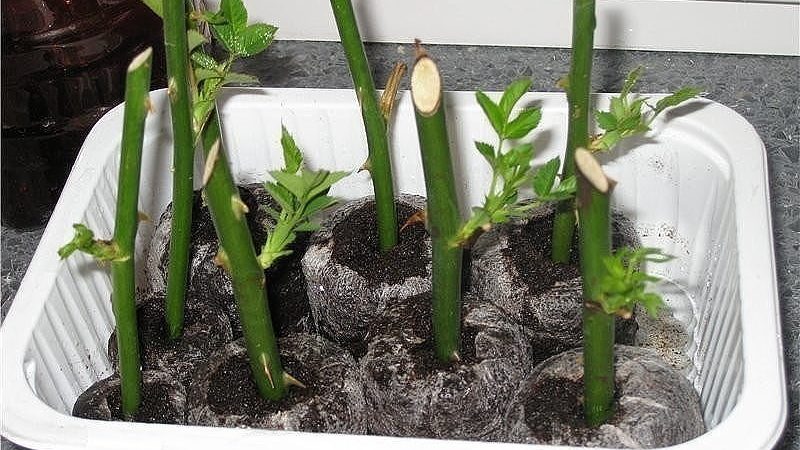
How to check safety
How to check how well the planting material survived the winter? About 24 hours before planting, the cuttings are carefully inspected:
- they must be resilient and elastic, not break when bent;
- the bark should be green, without dry or wrinkled areas;
- a cut of wood is light green in color (brown or dark brown inclusions indicate the death of the workpiece);
- the kidneys are tightly fixed;
- bud scales are smooth and elastic;
- The bud in cross section is light green.
There is a test for freezing cuttings. To do this, the cuts are renewed at an angle of 45°, and the blanks are shortened by 1 cm. The cuttings are placed in a jar with settled water. If they are healthy, the water will remain clear; if a cloudy yellowish-brown color appears, the cuttings are frozen.
Important! It is not recommended to use low-quality planting material.Damaged shoots will not take root in the soil because they have lost their vitality.
How to plant
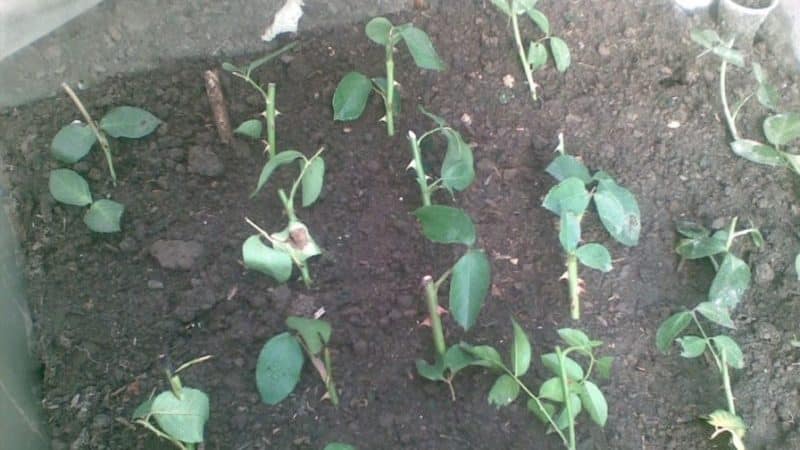
In the Moscow region, planting of a rosary begins in mid-April - early May, in the southern regions - in late March - early April.
Algorithm for planting roses:
- The location is chosen away from drafts. The area should be well lit by the sun, since roses grow poorly in the shade and often get sick. Wrong choice of location reduces the likelihood of lush flowering.
- If roses have already been grown on the site, the soil is replaced with a new layer of up to 0.5 m.
- The size of the planting holes is 40x60 cm. The depth depends on the length of the rhizome, to which 15 cm is added.
- Humus and ash (1:1) are placed at the bottom of the pits, clean soil is poured on top and a low mound is formed.
- Prepare a clay mash in a separate bucket and dip the roots into it immediately before planting.
- Plants are planted on mounds and the roots are carefully straightened.
- The holes are filled with earth so that the grafting site is 5-6 cm underground. The soil near the trunk is thoroughly compacted and watered.
- The beds are mulched with humus, peat or compost.
Advice from experienced flower growers
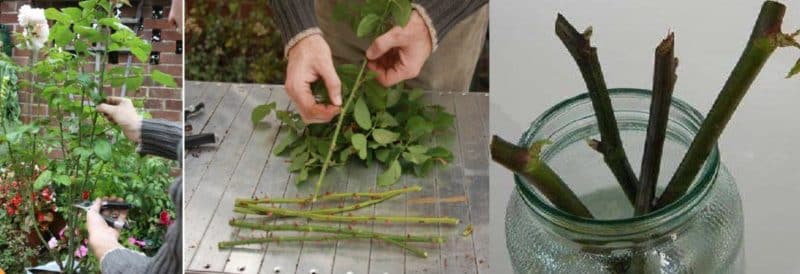
Take advantage of the advice of experienced gardeners who will help you create a lush rose garden in your garden:
- If the cuttings have dead, dry, brown shoots, cut them obliquely to the first dormant bud.
- The depth of the planting hole must be sufficient to accommodate the root system.
- Bury the grafting site 4-5 cm into the ground, then carefully fill the hole with clean soil and water it generously.
- If the rose's root system is wrapped in biodegradable material, plant the cuttings directly in it.
- Remove broken, non-viable and diseased roots, treat the sections with a solution of biofungicide (Ampelomycin, Fitosporina, Mikosana, Glyokladina).
- Before planting, trim the roots by 2 cm to reveal the core. It should be light, without dark inclusions.
- Remove paraffin from cuttings before planting so as not to interfere with roses growing and breathing.
- Pre-soak the cuttings in clean water for 2-3 hours to replenish the moisture deficiency. Add a growth stimulator and make sure the root collar remains above the surface of the water. Then move the seedlings into a solution of copper sulfate for disinfection for 30 minutes.
- Choose areas for planting on slopes at an angle of 8–10°.
- After planting, shade the seedlings from direct sunlight (for example, with cardboard). After glossy leaves appear, remove the cover. This means that the roses have begun to grow and no longer need shading.
- Too wet, acidic, sandy soil with a high salt content is not suitable for planting roses. To normalize the pH, add slaked lime or dolomite flour (400–500 g per 1 m²). The optimal soil acidity is slightly acidic (pH 5.5–6.5).
- Maintain distance between bushes and do not plant cuttings too close. Closing foliage leads to the development of fungal infections. The optimal distance between bushes is 50–100 cm.
Conclusion
The preparation of rose cuttings begins mainly in the fall, when the bushes have faded and it is no longer a shame to carry out pruning. Store planting material in the cellar at a temperature not exceeding +7°C, on the bottom shelf of the refrigerator, on the balcony, buried under a rose bush or in the ground, wrapped in sphagnum, and rooted in potato tubers.Each of these methods is good in its own way and guarantees excellent results provided the temperature and humidity are maintained.
When planting, it is important to choose the right place, protected from drafts and gusty winds, with good lighting. Roses grow best in hilly areas and slightly acidic soils with a pH of 5.5–6.5.